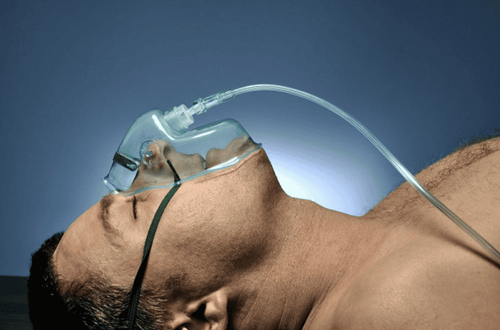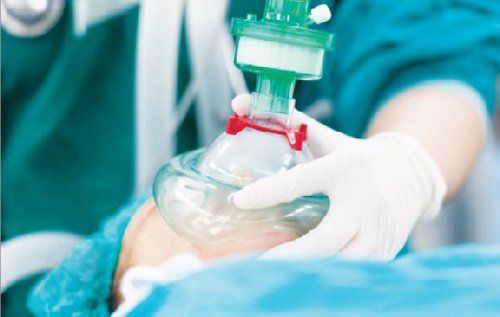This is an automatically translated article.
The article was professionally consulted by Specialist Doctor I Ho Quoc Tuan - Anesthesiologist - General Surgery Department - Vinmec Nha Trang International General Hospital.There are many methods of anesthesia in uterine malformation surgery. Depending on the degree of uterine malformation to choose the appropriate method. In particular, laryngeal mask anesthesia is a method used for short and not too complicated surgery cases.
1. Laryngeal mask anesthesia
The laryngeal mask is a means of opening the upper airway, consisting of a large barrel and an elliptical balloon at the lower end. Once placed and inflated, the balloon is closed with low pressure around the larynx entrance. Due to its convenience and nature, airway control is easier than with an endotracheal tube. Therefore, the laryngeal mask has been put into application in the difficult airway control regimen in anesthesia resuscitation, especially in the situation where ventilation is not possible, intubation is not possible.Laryngeal mask anesthesia is a method of giving anesthetic drugs into the body through the nose and mouth to temporarily lose consciousness, sensations and reflexes of the patient. Laryngeal mask anesthesia is applied to surgeries that are not too complicated, have a short surgical time, and have little effect on breathing and hemodynamics.
2. Laryngeal mask anesthesia in uterine malformation surgery
2.1 Uterine malformation surgeryUterine malformation has many shapes such as:
No uterus Double uterus, ectopic uterus Separated uterus Hypoplastic uterus Depending on the degree of uterine malformation is simple or complicated, open surgery or laparoscopic surgery to choose the appropriate anesthetic method. Laryngeal mask anesthesia is indicated for short surgical procedures that do not affect breathing and hemodynamics. In addition, it is contraindicated in patients who are allergic to anesthetics and in patients with a full stomach.

Step 1: Preparation
The person performing laryngeal mask anesthesia in uterine malformation surgery is a doctor and nurse specializing in anesthesiology. In addition, it is necessary to prepare some tools to serve in anesthesia such as: Anesthesia machine, suction machine, endotracheal lamp, endotracheal tube of various sizes, laryngeal mask of all kinds. Tracheal suction tubes, canuyn mayo Syringes of all kinds used for injecting anesthetics, morphine and muscle relaxants, inflating endotracheal tubes with balloons. Anesthetics used in anesthesia such as: Diprivan 200mg/20ml, esmeron 50mg/5ml or tracrium 25mg/2.5ml, fentanyl 0.1mg/2ml Painkillers: paracetamol, morphine Infusion fluids: ringer lactate, ringerfundin ,... Anti-shock box Before performing anesthesia surgery, the patient needs to prepare psychologically and be explained by the doctor about the purpose and possible complications. The patient will then sign the pledge. Note, do not eat or drink for at least 6 hours before surgery.
Step 2: Steps to take
Steps to administer laryngeal mask anesthesia in uterine malformation surgery:
Review the patient's general condition such as: Cardiopulmonary examination Prognosis the risk of difficult intubation such as: : Mouth opening, mallampati,... Place a peripheral intravenous line and infusion of ringer lactate or ringerfundin solution Get a monitor to monitor vital signs: breathing rate, pulse, temperature, blood pressure, oxygen saturation. Give the patient oxygen at a rate of 9 liters/minute, to increase the oxygen reserve before induction of anesthesia Conduct general anesthesia for the patient Inject fentanyl 0.2 mg, then inject diprivan anesthetic at a dose of 2 mg/kg, Use a quick-acting muscle relaxant if needed. When the patient loses consciousness, a laryngeal mask is placed. The technique to place the laryngeal mask is as follows:
Place the patient's head in an intermediate or slightly supine position. Hold the laryngeal mask like a pen, place your index finger at the junction between the laryngeal mask and the tube. One hand opens the patient's mouth. With the other hand, put the laryngeal mask through the dental arches to the base of the tongue, put the back of the mask on the hard palate, push the mask to slide along the hard palate to enter the hypopharynx. Stop when encountering resistance. Inject the cuff according to the volume indicated on the laryngeal mask. Check tightness of laryngeal mask: no air leak, easy ventilation Check correct position of laryngeal mask by auscultation and EtCO2 result Fixed with adhesive tape. Maintain anesthesia:
Maintain anesthesia with intravenous or volatile anesthetics, analgesics, muscle relaxants (if needed), control breathing by machine Monitor the depth of anesthesia based on heart rate, blood pressure, mechanical ventilation parameters: airway pressure, breathing, respiratory rate,... And symptoms such as sweating, lacrimation, MAC, BIS and Entropy (if any)... Monitor the Vital signs include: Heart rate, blood pressure, blood oxygen saturation SpO2, EtCO2, and body temperature. Closely monitor for laryngeal mask drop. Ensure the patient is well ventilated, deep anesthesia begins to conduct sterilization and surgery.
3. Monitoring and handling of accidents

Patient can have the laryngeal mask removed if the following criteria are met:
Patient is awake and following commands Raise the head for more than 5 seconds Spontaneous breathing and respiratory rate within normal limits Pulse and blood pressure Stable Body temperature >35 degrees Celsius No complications of anesthesia and surgery After surgical anesthesia, patients may experience some complications such as:
Reflux of gastric juice into airways: Need to monitor and prevention of lung infections after surgery Hemodynamic disorders: hypotension, cardiac arrhythmias, arrhythmias, slow and fast pulses,... Accidents caused by laryngeal mask such as: laryngeal mask not being placed, spasm laryngotracheal-bronchial mask, trauma when wearing a laryngeal mask,... Respiratory complications: folding, slipping of the laryngeal mask, opening of the respiratory system,... Complications after removing the laryngeal mask: respiratory failure, sore throat, hoarseness, upper respiratory tract infection, laryngotracheal-bronchospasm,... In summary, laryngeal mask anesthesia for uterine malformation surgery is a method used for with cases of surgery in the short time, and not too complicated. After surgery, patients may experience some complications. Therefore, the patient needs to be monitored and when there are abnormal signs such as shortness of breath, sore throat, low blood pressure, slow or fast heartbeat, etc., it is necessary to notify the medical staff for timely treatment. .
Vinmec International General Hospital with a system of modern facilities, medical equipment and a team of experts and doctors with many years of experience in medical examination and treatment, patients can rest assured to visit. examination and treatment at the Hospital.
Doctor Quoc Tuan has many years of experience in the field of Anesthesiology - resuscitation at Hoan My Danang Hospital and Phu Yen Provincial General Hospital before being an Anesthesiologist and resuscitator at the Operating Room - Department of Medicine. General surgery at Vinmec Nha Trang International General Hospital as it is today.
Please dial HOTLINE for more information or register for an appointment HERE. Download MyVinmec app to make appointments faster and to manage your bookings easily.














